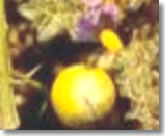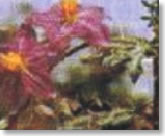KANTAKARI
Botanical Name: Solanum surattens Burm.f. (SOLANACEAE)
English Name: Yellow berried Night-shade
Hindi Name: Choti kateri, bhatkataya

Introduction: This plant is known for its medicinal benefits for times immemorial. In Panini Guhyasutras this plant was mentioned ( P.G.4/3/154 & 167). In Atharva Parisista Vyaghri and Simhi are mentioned together ( S.surattens & S. indicum). Vagbhata emphasized its utility in the treatment of cough/ respiratory disorders. It is one among the the Dasamulas. Kayyadeva nighantu ( a lexicon on herbs) did mention two varieties of Kantakari viz.m blue & white varities. He also mentioned two varieties of Brihati viz., blue and white variety. They appear to be morphological variations of botanically similar plants. In Raja nighantu we come across eight varieties of kantakari which include other related species like S. anguvim, S. trilobatum etc.
Distribution: A prickly, diffuse herb found commonly in waste lands and road-sides throughout India.
Chemical Constituents: Solasodine, solamargine, beta-solamargine, solasonine, solasodineo-L-rhamnosyl –B- D- glucoside (solasurine), solanocarpine (slanine-S), tomatidienol etc.
Parts Used: Whole plant, root& fruit.
Properties: Bitter-acid, stimulant, anti-tussive, bronchodilator, digestive, diuretic, anti- inflammatory etc.
Indications: Respiratory disorders, asthma, inflammatory / non- inflammatory edema, anemia etc.
Dose: Decoction 40-80 ml; powder 3-6 g.
Therapeutic Uses:
- Asthma: Its fruit+ anola+ asefoetida ½ part ml/day.
- Cough: Decoction made with Kantakari and long pepper will be useful.
Scientific Studies:
Anti-hypertensive activity: Crude plant extract caused hypotension which is attributed to release of histamine ( IJMR, 1967, 55, 723).
Anti-asthmatic activity: It is found to be beneficial in reducing breathlessness and cough in asthmatic patients owing to the depletion of histamine from lungs and expectorant action due to inorganic nitrate content (J.Res. Ind. Med. 1971, 6, 200).
Anti-tussive activity: The efficacy of Kantakari on non-specific cough and other respiratory disorders is reported (Chopra, 1970; Krishna, 1971 & Singh, 1990).
Cultivation Technology: The plant grows well in loam to sandy-loam soils of open places. Seeds are soaked in water/ cow urine for 10-12 hours to obtain good germination. The field is well ploughed and farm yard manure is added to soil prior to sowing / transplanting. 10-15 cm long seedlings are transplanted to the main plots at the distance of 30x30 cm in the month of June-July. Irrigate the field immediately after transplanting and later as and when required.
Harvesting: Roots are collected along with aerial portions and dried in shade.








